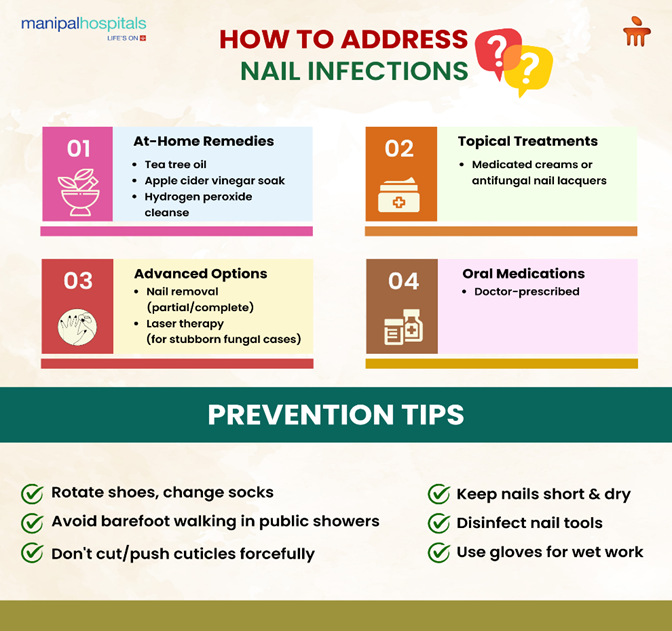
Nails can reflect more than just our grooming practices, although we usually tend to ignore them. Signs of trouble with nails can be discolouration, variations in texture, or pain in the nails. Nail infections specifically can be an early indication of other medical issues and require us to pay more attention. In this blog, a top dermatologist on Sarjapur Road, Bengaluru, explains in detail the nail infection causes, their types, the connection between nails and general health, and nail infection treatments.
Synopsis
Common Nail Infection Causes
Infections caused by penetration of microbes, such as bacteria and viruses, and sometimes even fungi, into the skin beneath the nails are among the commonest nail infection causes. Both fingernails and toenails are susceptible to infection; however, toenails are typically at a higher risk because of the warm, damp conditions created by shoes. Plus, they are the most exposed to dirt and germs.
Nail Infection Types
-
Fungal Infections (Onychomycosis): This can be a nail infection that can frequently occur in some people. The infection mostly starts as a whitish or yellowish colouration under the surface of the nail. Gradually, it progresses to the thickening stage and leads to discolouration or makes the nails brittle.
-
Bacterial Nail Infections (Paronychia): Recurrent nail biting is the main cause of this infection. Other forms of nail trauma and excess exposure to water can also cause an infection by allowing bacteria to infiltrate the skin next to the nail. Paronychia presents with symptoms such as tenderness, swelling, inflammation, or pus formation in some cases.
-
Yeast Infections (Candidiasis): Extended exposure to moisture or compromised immune function can create conditions on the skin that encourage the overgrowth of a type of yeast called Candida. Infected nails may change shape, change in colour, or partially separate from the nail bed.
-
Warts from Viral Infections: The human papillomavirus (HPV) can result in periungual warts, which develop near or beneath the nail. These growths can interfere with normal nail development and potentially cause pain or discomfort.
Nail Infection Causes
One of the most common causes of nail infections is inadequate nail care. However, underlying health conditions also frequently play a role in the onset of infections. Here are some of the causes for different nail infection types:
-
Compromised Immune Function: Long-term diseases such as autoimmune disorders or diabetes can hinder the body's ability to protect against infections. This can increase the susceptibility of nails to microbial invasion.
-
Circulation Issues: Poor blood flow, particularly to the extremities, might compromise the body's ability to ward off infections.
-
Nutrient deficiencies: A shortage of vital nutrients like biotin, iron, or zinc can compromise the structure of nails and make them more susceptible to infection.
-
Dermatological Issues: Certain dermatological disorders, such as psoriasis, which modifies the structure and health of the nail bed, can also cause infections under the nails.
-
Prolonged Moisture Exposure: Individuals who regularly come into contact with water, such as swimmers or cleaning professionals, often experience softened skin around the nails. This softened skin is more susceptible to bacterial or fungal invasion, amplifying infection risk.
Signs of Skin Infections
Before the infection worsens, it is crucial to identify the early warning signs. Common symptoms include:
-
Discolouration that is yellow, green, or dark
-
Nails that are brittle or thickened
-
Discomfort or inflammation around the nail
-
Abscesses are full of pus
-
Lifting or separating the nail from the nail bed
-
Discharge with a putrid odour
How to treat nail infections?
Nail infection treatment includes both home remedies and medical management as discussed below:
1. At-Home Treatments
Home remedies can effectively treat mild infections of the nails, particularly those caused by fungal infections. However, it should be noted that home remedies often take time to show results. In some cases, they may not be sufficient for addressing more serious infections and need more advanced nail infection treatment.
Here are common home treatments:
-
Tea Tree Oil: Renowned for its antibacterial and antifungal properties.
-
Apple Cider Vinegar: A natural treatment that could help decrease fungal growth when soaked in warm water.
-
Hydrogen peroxide: This can aid in cleansing the affected area and restrict the advancement of the infection.
-
2. Topical Therapies
Prescription-strength antifungal creams or medicated nail lacquers can be directly applied to the infected nail area. Sometimes, it might take weeks or months to completely cure some infections.
3. Oral Antifungal Medications
For more advanced or stubborn infections, doctors may prescribe oral antifungal agents such as itraconazole or terbinafine. These medications tend to be more effective but can carry risks. Hence, they should only be taken under medical supervision.
4. Nail Removal Surgery
In cases where the infection is severe or the nail has sustained significant damage, the skin specialist might recommend partial or complete removal of the nail. This allows for better healing and regrowth of healthy nail tissue.
5. Laser-Based Therapies
This is a more modern technique which mainly targets fungal infections using focused laser light. effectively terminating the fungus without harming the surrounding skin or nail structure. While promising, laser treatment tends to be costlier and may not be readily available in all clinics.

Nail Health as a Window to Overall Well-being
Recurrent or chronic nail infections may reflect deeper health concerns and shouldn’t be ignored:
-
Diabetes: Elevated blood sugar levels create a favourable environment for fungal growth.
-
Thyroid Disorders: Abnormal nail changes can be early indicators of hormonal imbalances.
-
Immune Deficiencies: Conditions like lupus or HIV can compromise the body’s infection-fighting abilities.
-
Nutritional Gaps: Brittle, easily infected nails might signal a lack of essential nutrients.
Tips to Prevent Nail Infections
Preventive care is often simpler and less costly than treatment. Consider adopting the following habits:
-
Maintain clean, dry nails.
-
Keep them neatly trimmed and avoid prolonged exposure to moisture.
-
Refrain from forcefully pushing back or slicing cuticles.
-
Use breathable shoes and change your socks often.
-
After each usage, disinfect grooming instruments.
-
Wear gloves when working with chemicals or performing wet tasks.
-
Avoid walking barefoot in locker rooms and public showers.
Conclusion
Although often seen as minor cosmetic issues, nail infections can actually reflect broader health concerns. By identifying the types of nail infections, understanding their underlying causes, and applying the right treatment strategies, individuals can improve nail health while gaining valuable clues about their overall well-being.
Timely diagnosis and consistent care through traditional remedies or clinical treatments are needed for recovery. Nail changes shouldn't be overlooked, as they might offer early warning signs about internal health imbalances. Visit the dermatology department at Manipal Hospitals Sarjapur Road for a thorough evaluation and personalised treatment. Book your consultation today.
FAQ's
A nail infection is considered serious if symptoms worsen over time or don’t improve with basic care. Look out for increasing pain, spreading redness, pus discharge, or if the nail begins to lift from the bed. If these signs are present, especially with fever or swelling, consult a doctor immediately. Chronic or recurring infections can signal underlying health issues like diabetes or immune system concerns.
A nail infection is considered serious if symptoms worsen over time or don’t improve with basic care. Look out for increasing pain, spreading redness, pus discharge, or if the nail begins to lift from the bed. If these signs are present, especially with fever or swelling, consult a doctor immediately. Chronic or recurring infections can signal underlying health issues like diabetes or immune system concerns.
Mild infections, particularly fungal ones, might show improvement with good hygiene and over-the-counter remedies. However, most nail infections do not fully resolve without treatment. Without proper care, the infection could worsen, spread, or become chronic. Seeking early medical advice is the best way to ensure proper healing and to rule out deeper causes.
Mild infections, particularly fungal ones, might show improvement with good hygiene and over-the-counter remedies. However, most nail infections do not fully resolve without treatment. Without proper care, the infection could worsen, spread, or become chronic. Seeking early medical advice is the best way to ensure proper healing and to rule out deeper causes.
Home remedies like tea tree oil or apple cider vinegar may help with early-stage fungal infections, but they’re not always reliable. It’s safe to try these methods for a few weeks, but if there’s no improvement or if symptoms worsen, it’s important to see a doctor. Self-treatment without understanding the infection type might lead to complications.
Home remedies like tea tree oil or apple cider vinegar may help with early-stage fungal infections, but they’re not always reliable. It’s safe to try these methods for a few weeks, but if there’s no improvement or if symptoms worsen, it’s important to see a doctor. Self-treatment without understanding the infection type might lead to complications.
Recurrent nail infections are often linked to systemic issues. Common culprits include diabetes (due to poor circulation and high sugar), thyroid disorders, weakened immune systems, and nutrient deficiencies like low zinc or biotin. If you frequently get nail infections, it might be a sign that an underlying health issue needs investigation.
Recurrent nail infections are often linked to systemic issues. Common culprits include diabetes (due to poor circulation and high sugar), thyroid disorders, weakened immune systems, and nutrient deficiencies like low zinc or biotin. If you frequently get nail infections, it might be a sign that an underlying health issue needs investigation.
If your job involves water exposure like cleaning, cooking, or swimming, prevention is the first step. Wear waterproof gloves, dry your hands and feet thoroughly, and use an antifungal powder regularly. Keep nails trimmed and avoid cutting cuticles. Rotate shoes and change socks daily to reduce moisture build-up. These small habits can greatly reduce your infection risk.
If your job involves water exposure like cleaning, cooking, or swimming, prevention is the first step. Wear waterproof gloves, dry your hands and feet thoroughly, and use an antifungal powder regularly. Keep nails trimmed and avoid cutting cuticles. Rotate shoes and change socks daily to reduce moisture build-up. These small habits can greatly reduce your infection risk.





















 5 Min Read
5 Min Read













